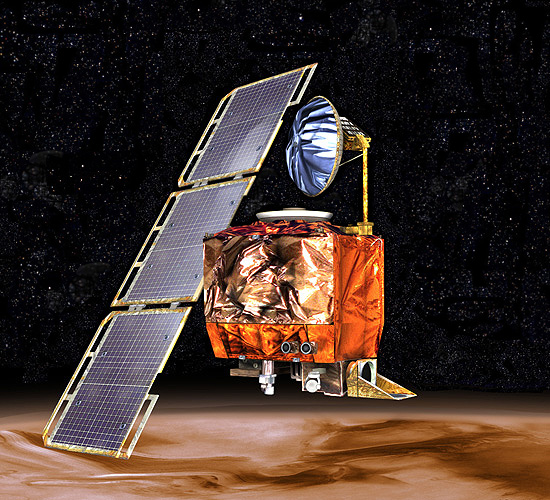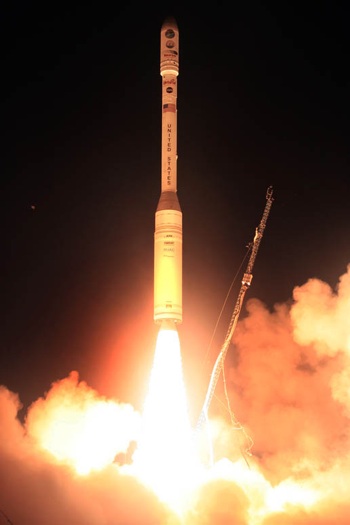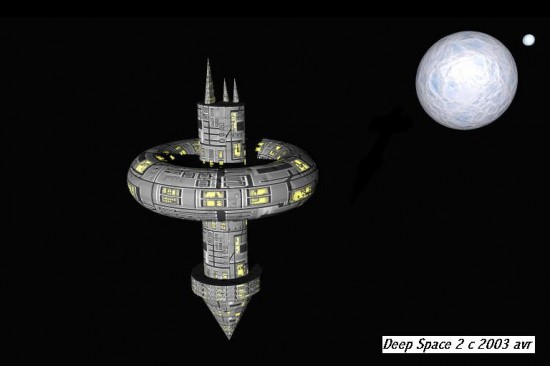#3 Deep Space 2
Deep Space 2 was two small sized probes launched on the same mission as MPL i.e. to collect specimens and generate data about the environment and surroundings of the red planet. It consisted of ten experimental technologies each failed to respond to a final communication effort by NASA engineers. The Project Manager proposed that the reason behind failure of communication could be due to the shortage of power supply.
[youtube]http://www.youtube.com/watch?v=RjMtjSYjRlc[/youtube]
#2 Mars Climate Orbiter
The Mars Climate Orbiter, formerly known as the Mars Surveyor ’98 Orbiter, was a 338 kilogram (750 lb) robotic space probe launched by NASA on December 11, 1998. It was made to determine the distribution of water on Mars, monitor the daily weather and atmospheric conditions, record changes on the surface of MARS due to wind and other atmospheric effects, determine temperature profiles of the atmosphere, monitor the water vapor and dust content of the atmosphere and look for evidence of past climate change. But unfortunately on September 23, 1999, communication with the spacecraft was lost as the spacecraft went into orbital insertion, due to a navigational error. The spacecraft encountered Mars at an improperly low altitude, causing it to incorrectly enter the upper atmosphere and disintegrate. Several teams had been working on the project. NASA had been working in metric units for several years but one of the teams used English units and the lack of conversion meant that the Climate Orbiter approached Mars from an altitude of 60 kilometers (37 miles) instead of 150 kilometers (93 miles). The failure board’s first report identifies eight contributing factors that led directly or indirectly to the loss of the spacecraft. These causes include inadequate consideration of the entire mission and its post-launch operation as a total system, inconsistent communications and training within the project, and lack of complete end-to-end verification of navigation software and related computer models.”The ‘root cause’ of the loss of the spacecraft was the failed translation of English units into metric units.

[youtube]http://www.youtube.com/watch?v=ZD4jPnk49PE[/youtube]
#1 NOAA-19
NOAA-19 was the last in a series of weather satellites that monitor atmospheric conditions, follow volcanic eruptions and conduct climate research. On 4 November 2008, NASA announced that the satellite had arrived at Vandenberg aboard a C-5 Galaxy military transport aircraft. Installation of the payload fairing took place on 27 January 2009. Second stage propellant was loaded on 31 January 2009. Several attempts were made to conduct the launch. The first attempt to launch was abandoned after a failure was detected in a launch pad gaseous nitrogen pressurization system. The second attempt was cancelled after the failure of a payload fairing air conditioning compressor, which is also part of the ground support equipment at the launch pad. The satellite was successfully launched aboard from Vandenberg Air Force Base on February 6th 2009. NOAA 19 carried a suite of instruments that provided data for weather and climate predictions. Like its predecessors, it could provide global images of clouds and surface features and vertical profiles of atmospheric temperature and humidity for use in numerical weather and ocean forecast models, as well as data on ozone distribution in the upper part of the atmosphere, and near-Earth space environments information important for the marine, aviation, power generation, agriculture, and other communities. On September 6, 2003, the satellite was badly damaged while being worked on at the Lockheed Martin Space Systems factory in Sunnyvale, California. The satellite fell to the floor as a team was turning it into a horizontal position. A NASA inquiry team determined that engineers failed to check if the satellite was bolted down before moving it, and accidentally knocked the multi-million dollar piece of equipment onto the ground, breaking a number of components.




